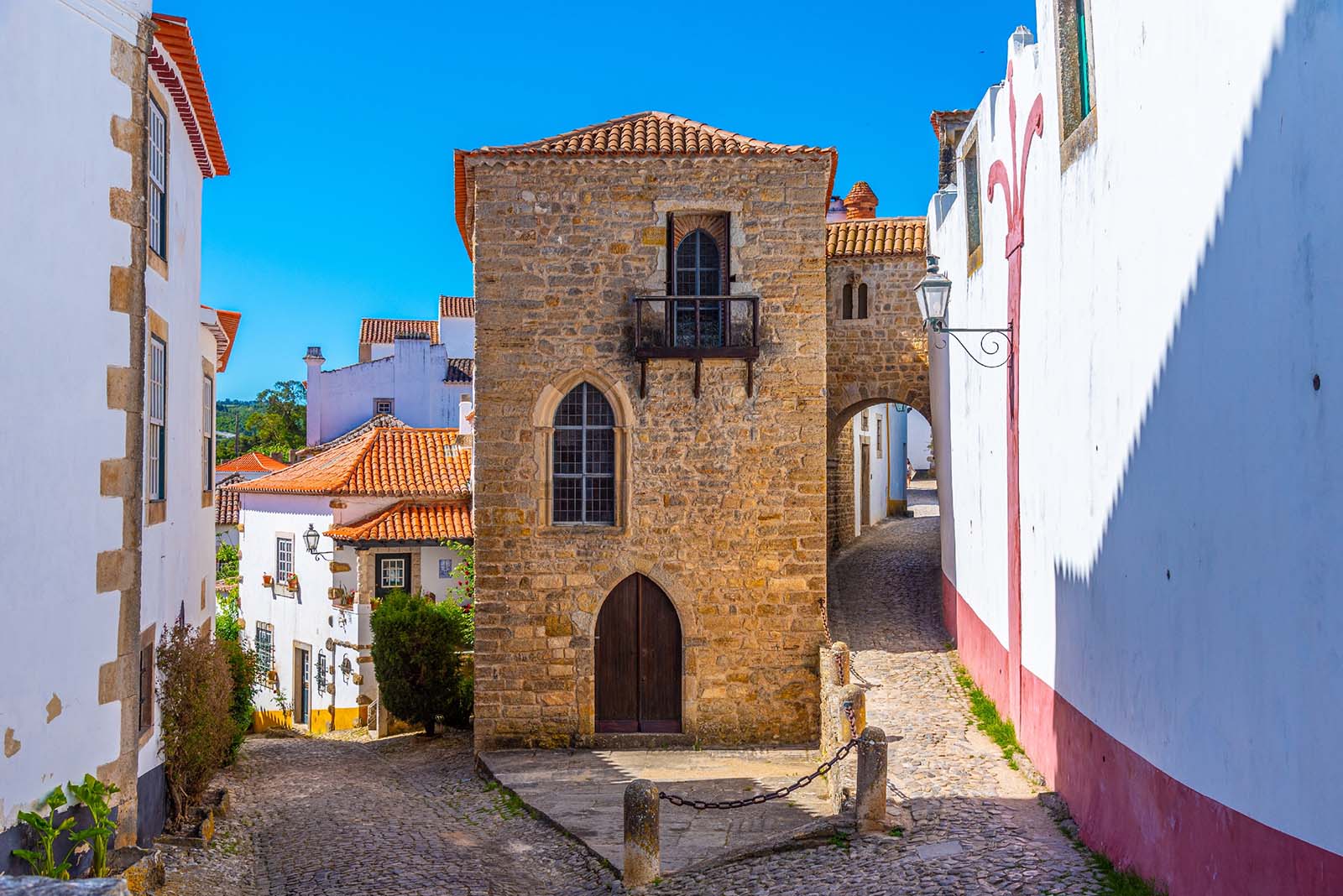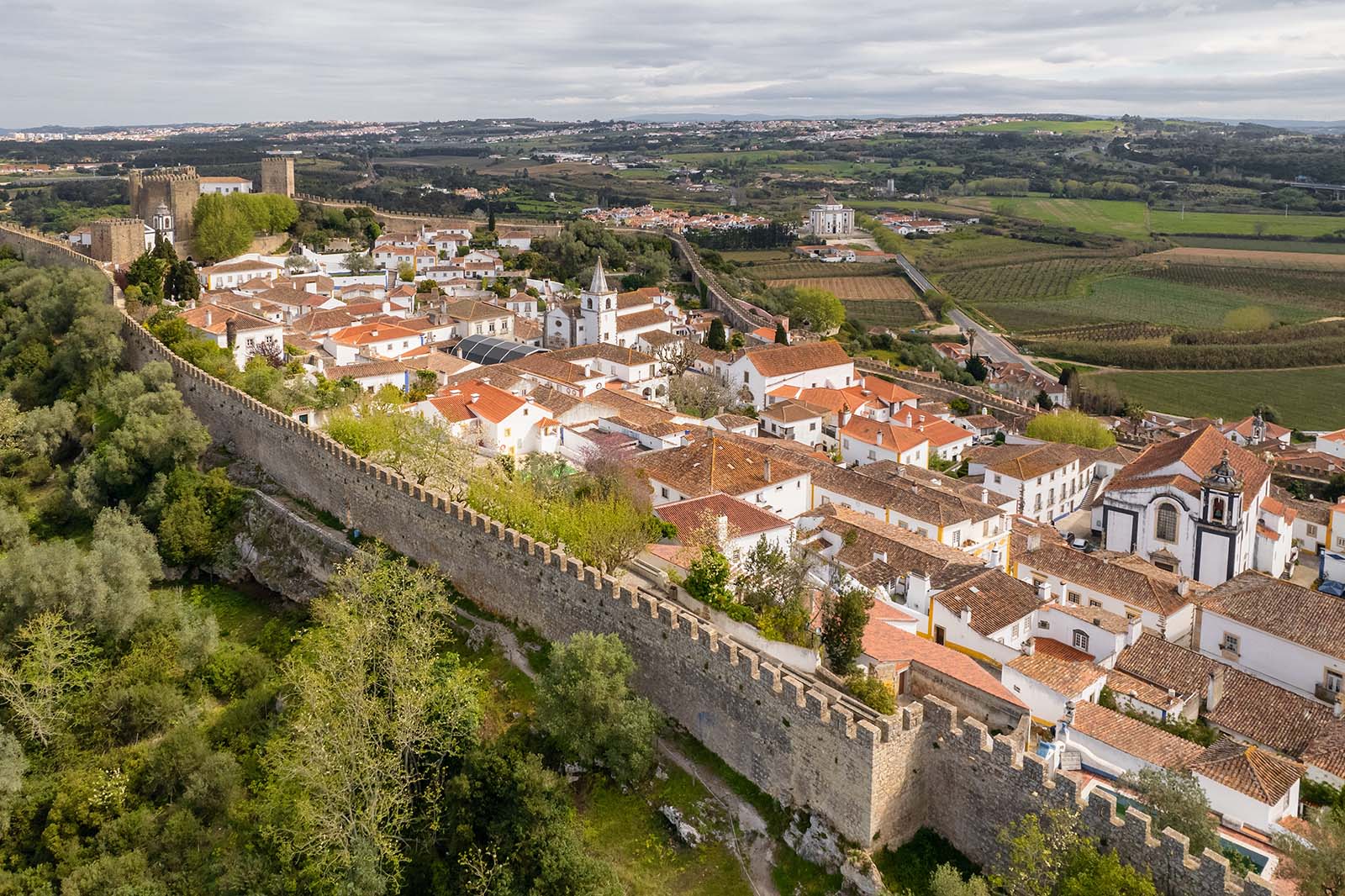Planning your own trip? Prepare for your trip
Use Rough Guides' trusted partners for great rates
Plan and book your private, tailor-made tour with vetted local experts
Óbidos is one of Portugal’s prettiest small towns, entirely wrapped in medieval walls that you can still walk today. Much of it was rebuilt after the 1755 earthquake, yet the cobbled alleys, whitewashed houses, and tiled churches preserve an old-world charm. For centuries, it was known as the “Wedding City,” since Portuguese kings often gifted the town to their queens.
The town once stood on the shoreline, with boats moored below its walls. As the sea retreated, it left a fertile plain and the Lagoa de Óbidos a few kilometers away, while the town itself became marooned inland. In 2015, UNESCO recognized Óbidos as a City of Literature, a nod to its bookshops and thriving creative scene.
Festivals add even more reason to visit: a Chocolate Festival each March, a summer program of concerts and medieval fairs from July to September, a Classical Music Festival in October, and a lively Christmas Fair that fills the streets with lights and markets. It's a must-see stop on any well-planned Portugal cities tour, blending history, creativity, and local flavor in one compact walled town.

Hey, I’m Sara, your Portugal travel expert. Óbidos is a town that feels like it was made for wandering. Inside the walls, you’ll find winding lanes, flower-draped houses, and stairways that always seem to lead to another view over the rooftops.
It may be small, but it is packed with character. You can walk the walls in less than an hour, duck into a bookshop hidden in a chapel, or sit with a shot of ginjinha in a chocolate cup while the day-trippers hurry past. Óbidos rewards a slower pace, and this guide will give you the essentials to enjoy it properly: how to get here, what to see, and where to stay when the gates close for the night.
Sara’s tip
Climb the town walls just before sunset. The light softens over the whitewashed houses, the lagoon glints in the distance, and most visitors have already left. It is the best moment to see Óbidos at its quietest.
Best time to visit
Spring from April to June brings long days, warm weather, and bougainvillea in bloom across the town walls. Autumn from September to October has mild air, golden light, and fewer crowds. July and August can be hot and busy, especially during the medieval fair, while winter is cooler and quieter, ideal if you prefer empty streets and a slower pace.
How to get to Óbidos
Óbidos is one of the easiest historic towns to reach from Lisbon. Direct buses run regularly from Campo Grande and take about an hour. Driving gives you more flexibility, with a journey of around 85 km that takes the same amount of time. Parking is available outside the town gates, since cars are not allowed inside the walls. The nearest train station is Óbidos itself, though rail services are slower and less frequent than buses.
Best areas to stay in Óbidos
Óbidos sits in central Portugal, about 85 km north of Lisbon and a short drive inland from the Atlantic coast. The town is perched on a hill, fully enclosed by medieval walls that overlook vineyards and the distant Óbidos Lagoon.
Often listed among the best places to visit in Portugal, Óbidos is a highlight on many a Portugal itinerary. Its location makes it an easy day trip from Lisbon, but staying overnight lets you enjoy the quiet once the tour buses leave. From here you can explore the nearby lagoon, visit the seaside town of Peniche, or head north to Alcobaça and Batalha to see two of Portugal’s most impressive monasteries.
















Óbidos is compact, enclosed by walls, and made for walking. Cars are not allowed inside the historic core, and the cobbled lanes are best explored on foot. Distances are short, but the stairways and uneven paving mean you will want decent shoes.
If you are asking how many days in Óbidos are enough, one full day will let you see the essentials: a walk along the town walls, the castle, the tiled churches, and time to wander the cobbled lanes lined with whitewashed houses. But if you can, stay overnight. Once the tour buses leave, Óbidos feels entirely different, quieter, softer, and far more atmospheric, with lamplight spilling over the streets.
If, for example, you are planning a 10-day itinerary in Portugal, it is worth giving Óbidos two days. Spend the first inside the walls, taking your time to explore the town and sample ginjinha in a chocolate cup, then use the second to explore nearby highlights. The Óbidos Lagoon is perfect for a morning walk, Peniche offers fresh seafood and Atlantic surf, and the monasteries of Alcobaça and Batalha are both within easy reach.

Castle of Obidos, Portugal © Shutterstock
Óbidos has a wide choice of stays, from boutique hotels in restored townhouses to simple guesthouses and rural retreats around the lagoon. Here’s where to base yourself depending on how you like to travel.
Óbidos may be small, but it is packed with sights, stories, and corners that reward slow exploration. Here’s a detailed list of the best things to do in Óbidos, each worth your time.
Óbidos’ walls are its most striking feature, completely circling the town with nearly two kilometers of ramparts. Climbing up the uneven stone stairs, you are rewarded with views over the red rooftops, the fertile plain, and the lagoon glinting in the distance. The path is narrow and without railings, so watch your step, especially with children, but the views are unforgettable.
Go early in the morning or near sunset, when the light softens and the crowds thin. Walking the walls gives you the best sense of how Óbidos once looked to defenders scanning for enemies, and to travelers approaching from the valley below.
The castle of Óbidos dominates the northern end of town. Built by the Moors and later reinforced by Portuguese kings, it has served as a fortress, a royal residence, and today partly as a pousada, a state-run historic hotel. Even if you are not staying overnight, it is worth wandering the courtyards and admiring the blend of stone walls and Gothic windows.
From outside, the castle’s towers are some of the most photogenic angles in Óbidos, especially when framed with bougainvillea in summer. If you happen to visit during the medieval fair, the castle grounds turn into a stage for jousts, feasts, and costumed parades, bringing its history vividly to life.
In the heart of town stands Santa Maria, the main church of Óbidos, rebuilt after the 1755 earthquake but still layered with centuries of history. It was here that King Afonso V married his cousin Isabel in 1441, when they were just children. Inside, white walls are patterned with blue-and-white azulejos, and the painted ceiling is a fine example of Portuguese baroque art.
It is usually quiet, making it a peaceful pause before returning to the busy main street. Outside, the square often hosts markets and performances, so you can step from solemn history back into lively present-day Óbidos in moments.

A narrow street inside of the obidos castle in Portugal © Shutterstock
Óbidos was named a UNESCO City of Literature in 2015, and you notice it immediately in the number of bookshops tucked into unexpected places. There is a bookshop in a former church, another in a wine cellar, and several lining the main street with shelves stacked high under painted ceilings.
Even if you are not shopping, the mix of books, history, and setting makes them worth a stop. Some of them are also cafés where you can stick around for a cup of coffee and a new book. If you're a book lover, Óbidos will feel like it was made just for you.
Rua Direita is Óbidos’ main artery, running straight from the southern gate to the castle. It is where most visitors start, and it is packed with shops selling ceramics, cork goods, and bottles of ginjinha, the cherry liqueur. It can be busy, especially on weekends, but the atmosphere is part of the experience.
Duck into side alleys when you want a break from the crowds. Here you find quieter houses, flowerpots on windowsills, and the occasional small chapel. By evening, once the day-trippers have gone, Rua Direita feels different: lantern-lit, calm, and more in tune with the town’s medieval spirit.
You cannot leave Óbidos without trying ginjinha, a sour cherry liqueur beloved across Portugal but most famously served here in small chocolate cups. The sweet bite of chocolate softens the tart liqueur, making it a fun ritual as well as a local specialty.
Shops along Rua Direita all claim to serve the “real” one, but in truth, they are much the same. Try one while wandering, and if you like it, buy a bottle to take home. It is a quick, cheerful experience that has become part of Óbidos’ identity.
Óbidos’ small but engaging museum sits just off the main square. Inside are paintings by Josefa de Óbidos, one of Portugal’s most famous female artists of the 17th century, alongside religious art, archaeological finds, and pieces that trace the town’s role through centuries.
It is not a large collection, but the combination of art and local history makes it worth an hour. For those who want more than just pretty streets, it provides valuable context about how Óbidos came to be such a prized possession of Portugal’s queens.
Just outside the town walls, you can see the aqueduct that once brought water from the surrounding hills. Built in the 16th century, it runs for several kilometers and is still an impressive feat of engineering. Today it no longer carries water, but its arches frame the approach to Óbidos and make a striking contrast with the whitewashed walls behind.
It is best seen in the late afternoon light, when the stone glows warm against the fields. A short walk from the main gate brings you up close, where you can appreciate the scale and the care taken in its construction.
Óbidos’ calendar is packed with events that transform the town. In March, the Chocolate Festival fills the streets with sculptures, tastings, and workshops. Summer brings the Medieval Fair, with jousts, costumes, and markets spilling through the castle grounds. October hosts the Classical Music Festival, while December sees the town turn into a Christmas village with lights, skating, and stalls.
If you plan your trip around one of these, book accommodation early. Festivals draw crowds from Lisbon and beyond, but they also show Óbidos at its most playful, when history and modern celebration blend seamlessly.
A short drive from the town walls takes you to the Lagoa de Óbidos, a shallow lagoon connected to the Atlantic. It is popular for kayaking, birdwatching, and walking along the sandy edges. Families use it as a safe swimming spot in summer, while windsurfers and sailors enjoy its breezes.
From the lagoon, continue to the fishing town of Peniche for seafood and a taste of Portugal’s surf culture, or head north to the monasteries of Alcobaça and Batalha. Having Óbidos as your base makes it easy to mix medieval charm with coastal energy in the same trip.

Aerial view of the historic walled town of Obidos, near Peniche, Portugal. Aerial shot of Obidos Medieval Town, Portugal © Shutterstock
Óbidos has a Mediterranean climate with Atlantic influence, which means warm, dry summers and mild winters that are wetter than inland Portugal. The best time to visit Portugal’s most photographed walled town depends on how you like to travel. Just 85 km north of Lisbon and a short drive from the coast, Óbidos has slightly cooler summers than the capital, but evenings can still feel warm well into autumn. Average temperatures range from about 46°F (8°C) in January to 82°F (28°C) in August.
Óbidos’ food scene is small but full of personality. Most restaurants are tucked into whitewashed houses inside the walls or in converted barns just outside. The focus is on traditional Portuguese flavors, especially hearty stews, fresh bread, and local seafood from the nearby coast. Menus are short, ingredients are seasonal, and portions rarely leave you hungry.

Ornate arches and pews in Iglesia de Santa Maria, Obidos, Leiria, Portugal © Shutterstock
Here are some unique experiences we can arrange for your tailor-made Óbidos trip: all private, flexible, and designed by our local travel experts.
Discover Portugal's most captivating stories
Use Rough Guides' trusted partners for great rates
written by
Olga Sitnitsa
Online editor at Rough Guides, specialising in travel content. Passionate about creating compelling stories and inspiring others to explore the world.